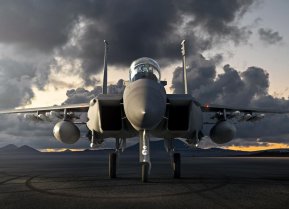F-16XL: The Warplane the Air Force Rejected That NASA Loves
While the F-16XL never made it to service with the Air Force, it eventually found its way to NASA where it has participated in numerous aeronautical research projects over the years.
Meet the F-16XL: As the world’s most capable fourth-generation multi-role fighter, the F-16 Fighting Falcon is well respected by aviation buffs and industry experts alike.
The American-made platform was designed as an air superiority fighter more nearly five decades ago and continues to fly for the U.S. Air Force in addition to numerous foreign militaries.
While the Fighting Falcon is a well-recognized airframe today, an even more capable F-16 variant was actually developed earlier but ultimately nixed before ever entering service.
The F-16XL was so impressive that it directly competed with the infamous F-15E when it was still under consideration.
A brief history of the F-16XL
When General Dynamics Fort Worth won the U.S. Air Force’s Lightweight Fighter program (LTF), its engineers began brainstorming an F-16 airframe equipped with both improved air-to-air and air-to-ground mission capabilities.
By the early 1980’s, the Air Force announced the Enhanced Tactical Fighter program in order to find a replacement aircraft for the F-111Aardvark.
The F-16XL design was submitted by General Dynamics, which legitimately competed with the McDonnell Douglas F-15E jet.
After a few years, the Air Force awarded McDonnell Douglas the contract and the two developed F-16XL fighters were relegated to Edwards Air Force Base. The F-15E possessed two engines that resulted in greater thrust and increased speed with a higher ceiling. Additionally, the winner was less pricey.
The F-16XL was truly a formidable fighter
The chief project engineer for the F-16XL, Harry J. Hillaker, revealed that the new variant retained the fundamental elements of the Fighting Falcon, with improved range and payload possibilities.
The F-16XL could sport twice the payload of the F-16 and travel up to 44% farther without the need for external fuel tanks, meaning that if an F-16XL had the exact same payload as an F-16A on a mission, the former could fly nearly twice as fast as the latter.
The advanced jet could also carry four Advanced Medium-Range Air-to-Air Missiles (AMRAAM) and two Sidewinder AIM-9 infrared missiles.
Air and Space Forces outlined other capabilities in a report on the fighter: “As for penetration and survivability, the F-16XL can dash supersonically with a load of bombs at either high or low altitude. It can climb at high rates with the bombs aboard. And it has a speed advantage of up to eighty-three knots over the F-16A at sea level at military power setting and 311 knots on afterburner at altitude while carrying a bomb load. Two additional capabilities of the F-16XL contribute to survivability. First is improved instantaneous maneuver ability coupled with greatly expanded flight operating limits (with bombs), and second is reduced radar signature resulting from the configuration shaping.”
The F-16XL’s cranked-arrow delta wing shape enabled the jet to fly at supersonic speeds without compromising subsonic stability and maneuverability.
With wings that featured increased surface area, the fighter had increased lift. Technically, the F-16XL’s specs resulted in a 25% higher lift-to-drag ratio and an 11% improvement in subsonic flight.
While the F-16XL never made it to service with the Air Force, it eventually found its way to NASA where it has participated in numerous aeronautical research projects over the years.
The formidable variant would even aid in the development of the supercruise capability of the first-ever fifth-generation jet to fly the skies- the F-22 Raptor.
Maya Carlin is an analyst with the Center for Security Policy and a former Anna Sobol Levy Fellow at IDC Herzliya in Israel. She has by-lines in many publications, including The National Interest, Jerusalem Post, and Times of Israel. You can follow her on Twitter: @MayaCarlin.
Image Credit: Creative Commons.


.jpg?itok=bTSlSbrF)